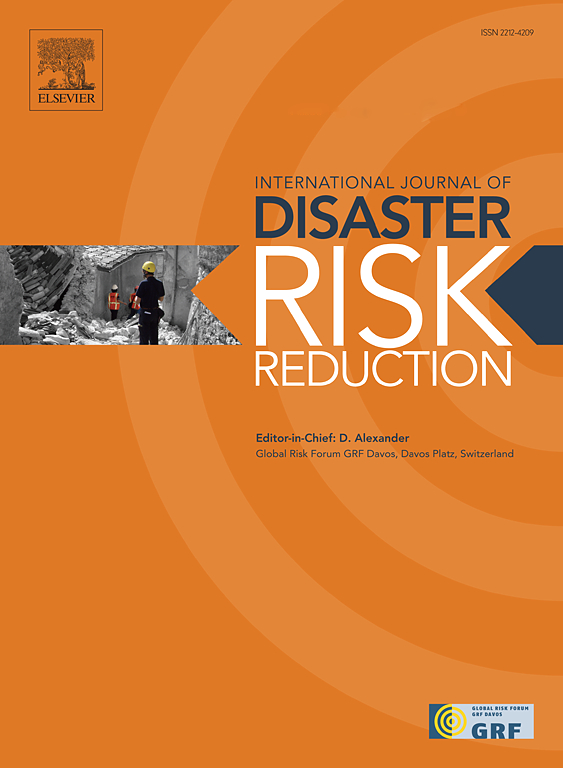灾难教育:基于被忽视的疏散后行为概念的漫画材料是否会影响人们在大地震后立即返回具有Natech风险的疏散建筑的选择性注意力?
IF 4.5
1区 地球科学
Q1 GEOSCIENCES, MULTIDISCIPLINARY
International journal of disaster risk reduction
Pub Date : 2025-07-11
DOI:10.1016/j.ijdrr.2025.105701
引用次数: 0
摘要
储存和处理危险物质(如易燃、氧化、有毒和窒息性化学品)的建筑物与一般建筑物不同。这些建筑容易受到自然灾害引发的技术灾难(natech)的影响,包括火灾、爆炸、中毒和窒息。先前的研究发现,大多数人更喜欢重新进入疏散后没有受损的建筑物。然而,在大地震发生后立即不安全地重新进入有危险材料的建筑物会带来重大风险,可能使主震幸存者的生命处于危险之中。本研究探讨了基于漫画的教育材料在大地震后立即选择性关注的有效性,重点是重新进入储存和处理危险物质的建筑物。对878名日本本科生和研究生进行了一项调查,收集了他们的人口统计信息,重点关注受访者在重返校园时的关注重点。结果显示,大多数重新进入疏散建筑的参与者在阅读教育材料之前,主要关注与地震活动有关的物品和/或事件,如坠落的物体和天花板。此外,参与者在阅读材料后继续将注意力集中在建筑物中的有害物质上。阅读以漫画为基础的材料的参与者比阅读以文本为基础的材料的参与者对有害物质的关注程度更高。这些发现支持开发与储存和处理危险物质的设施有关的有效灾害教育材料,从而大大减少与natech相关的风险。本文章由计算机程序翻译,如有差异,请以英文原文为准。
Disaster education: Do manga materials based on the overlooked concept of postevacuation behaviors affect selective attention in people returning immediately after a major earthquake to evacuated buildings posing Natech risks?
Buildings where hazardous materials (e.g., flammable, oxidizing, toxic, and asphyxiating chemicals) are stored and handled differ from general buildings. Such buildings are susceptible to natural hazard–triggered technological disasters (Natechs), including fires, explosions, poisoning, and asphyxiation. Previous studies have found that most individuals prefer to re-enter evacuated buildings that do not appear damaged. However, unsafe re-entry into buildings with hazardous materials immediately following major earthquakes poses significant risks, potentially placing the lives of those that survived the main shock at risk. This study probed the effectiveness of manga-based educational materials on selective attention immediately following major earthquakes, focusing on re-entry into buildings where hazardous materials were stored and handled. A survey was administered to 878 Japanese undergraduate and graduate university students that collected their demographic information, focusing on the respondents’ attention priorities during their re-entry. The results showed that most participants who re-entered evacuated buildings focused primarily on items and/or events such as falling objects and ceilings that were associated with seismic activity before reading educational materials. Moreover, participants continued to direct their attention to hazardous materials in the buildings after reading the materials. The participants who read manga-based materials demonstrated greater attention to hazardous materials than those who read text-based materials conveying equivalent content. These findings support the development of effective disaster education materials relating to facilities that store and handle hazardous materials, significantly reducing Natechs-associated risks.
求助全文
通过发布文献求助,成功后即可免费获取论文全文。
去求助
来源期刊

International journal of disaster risk reduction
GEOSCIENCES, MULTIDISCIPLINARYMETEOROLOGY-METEOROLOGY & ATMOSPHERIC SCIENCES
CiteScore
8.70
自引率
18.00%
发文量
688
审稿时长
79 days
期刊介绍:
The International Journal of Disaster Risk Reduction (IJDRR) is the journal for researchers, policymakers and practitioners across diverse disciplines: earth sciences and their implications; environmental sciences; engineering; urban studies; geography; and the social sciences. IJDRR publishes fundamental and applied research, critical reviews, policy papers and case studies with a particular focus on multi-disciplinary research that aims to reduce the impact of natural, technological, social and intentional disasters. IJDRR stimulates exchange of ideas and knowledge transfer on disaster research, mitigation, adaptation, prevention and risk reduction at all geographical scales: local, national and international.
Key topics:-
-multifaceted disaster and cascading disasters
-the development of disaster risk reduction strategies and techniques
-discussion and development of effective warning and educational systems for risk management at all levels
-disasters associated with climate change
-vulnerability analysis and vulnerability trends
-emerging risks
-resilience against disasters.
The journal particularly encourages papers that approach risk from a multi-disciplinary perspective.
 求助内容:
求助内容: 应助结果提醒方式:
应助结果提醒方式:


